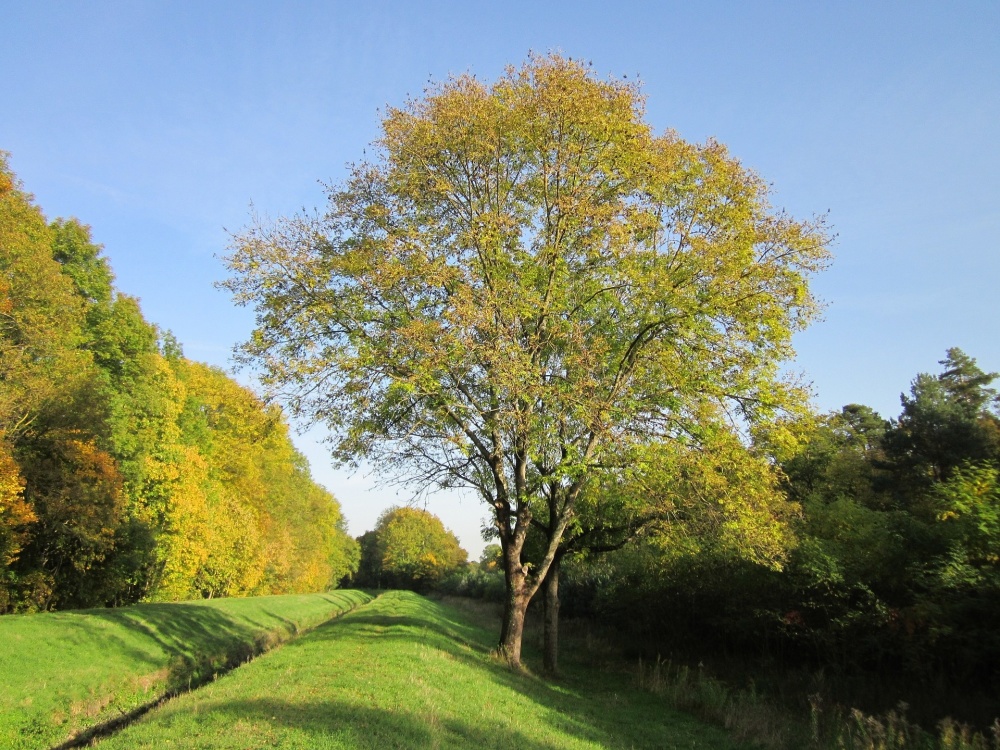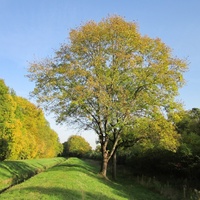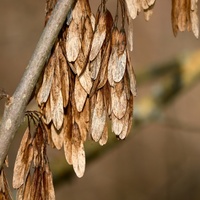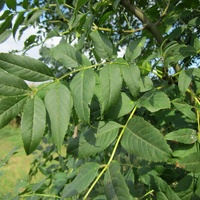Common name: Shamel ash
Other common names: Evergreen ash, Tropical ash
Description
Shamel ash or Tropical ash is a timber and landscape tree originating in the highlands of Central America, its native range extending from Mexico, through Guatemala and Honduras, to Costa Rica.
It is a medium-sized tree, typically 15 to 20 m (50 to 65 ft) tall in cultivation, 25 m (80 ft) or taller in the wild and usually with a straight, uniform trunk 1 m (3 ft) diameter. This supports a densely leaved, uniformly rounded crown. The bark is dark grey or brown, thick and furrowed into ridges.
The leaves are up to 30 cm (12 in) long and feathery, made up of five to nine dull dark green, elongated oval leaflets, sharply pointed, serrated on the margins and arranged in pairs along the length, except for a single leaflet at the tip.
The flowers are small and insignificant, without petals, green and either female or male on separate trees. They are borne in large, branched clusters up to 20 cm (8 in) long and come into bloom in the dry season.
The fertilised flowers on female trees are followed by small, flat, winged seedpods that hang in large clusters. They are green when young, becoming dry and light brown when mature, at which time they detach and glide to the ground.

Use
The wood is medium-weight, averaging 500 kg per cubic meter (31 lbs per cubic ft.), and has low natural resistance to rot and decay. It is classed as a non-durable hardwood, limiting its use outdoors or for in-ground construction.
The heartwood ranges from pale yellowish-brown to pale brown, with larges pores and a straight grain but is plainly figured. It is reportedly very similar to that of the White ash (Fraxinus americana). Suitably sized logs are sawn into planks or lumber used for making light furniture, cabinets, indoor flooring. It is also sliced into decorative veneer and turned or crafted into kitchen utensils and baseball bats.
It is a popular street and shade tree in cities and towns in its native range, owing to its moderate size, shapely form and eye-catching foliage.
Climate
Grows naturally in sub-humid to humid subtropical and tropical mid- to high-elevation climates, generally areas with annual lows of 8 to 17°C, annual highs of 19 to 30°C, annual rainfall of 700 to 3000 mm, and a dry season of 7 months or less, extending to drier areas with irrigation or groundwater.
Growing
Performs best on moderately rich, moist, free- to slow-draining clay-loam, loam, sandy-loam and loamy-sand soils of an acid to neutral nature, generally with a pH of 5.0 to 7.5, and on sites with full to partial sun exposure.
Problem features
Female trees produce large amounts of seedpods that get carried on the wind, dispersing them a considerable distance from the parent tree. It is assessed as a high weed risk species for Hawaii, by the Hawaii Pacific Weed Risk Assessment (HPWRA) project.
Where it grows
References
Books
-
Editors of Sunset Magazine 2012, The New Western Garden Book: The Ultimate Gardening Guide, 9th edition, Sunset Publishing Corporation, California
-
Francis, J. K. 1998, Tree species for planting in forest, rural, and urban areas of Puerto Rico, U.S. Department of Agriculture, Forest Service, International Institute of Tropical Forestry, Río Piedras, Puerto Rico
-
Francis, J. K. and Liogier, H. A. 1991, Naturalized exotic tree species in Puerto Rico, General technical report SO-82, USDA Forest Service, Southern Forest Experiment Station, New Orleans
-
Francis, J. K. et al. 2000, Silvics of Native and Exotic Trees of Puerto Rico and the Caribbean Islands, Technical Report IITF-15, USDA Forest Service, Rio Piedras, Puerto Rico
-
Gilman, E. F. 1997, Trees for urban and suburban landscapes, Delmar Publishers, Albany, New York
-
Little, E. L. & Skolmen, R. G. 1989, Common forest trees of Hawaii (native and introduced), Agricultuural Handbook No. 679, Forest Service, U.S. Department of Agriculture, Washington, D.C.
-
Perry, B. 2010, Landscape plants for California gardens: an illustrated reference of plants for California landscapes, Land Design Publishing, Claremont, California
-
Randall, R. P. 2002, A global compendium of weeds, R.G. and F.J. Richardson Press, Melbourne
-
Randall, R. P. 2007, The introduced flora of Australia and its weed status, Cooperative Research Centre for Australian Weed Management, Glen Osmond, South Australia
-
Scheffer, T. C & Morrell, J. J. 1998, Natural durability of wood : a worldwide checklist of species, Forest Research Laboratory, Oregon State University, Corvallis, Oregon
-
Standley, P. C. 1920, Trees and shrubs of Mexico, Government Printing Office (GPO), Washington D.C.
-
Vázquez, Y. C. 1999, Potentially valuable Mexican trees for ecological restoration and reforestation, Institute of Ecology, Database SNIB-REMIB-CONABIO, Project J084, Mexico
-
Vozzo, J. A 2002, Tropical tree seed manual, U.S. Department of Agriculture (USDA), Forest Service, Washington D.C.
-
Whitesell, C. D. & Walters, G. A. 1976, Species adaptability trials for man-made forests in Hawaii. Research Paper PSW-RP-118, U.S. Department of Agriculture, Forest Service, Pacific Southwest Forest and Range Experiment Station, Hawaii
Articles, Journals, Reports and Working Papers
-
Skolmen R.G. 2000, Some woods of Hawaii: properties and uses of 16 commercial species, University of Hawaii, Honolulu, (Resource Managment; RM-7), 33 p.




